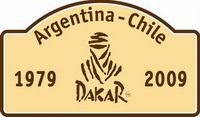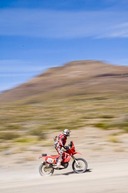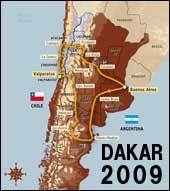2009 Dakar Coverage Tuesday - Chapter 4
 |
By Thom Cannell
Detroit Bureau
The Auto Channel
 |
Each passing vehicle spit sand and dust high, carried by the wind into our cars, eyes, cameras, ears, and hearts. If you love racing, this was perfection. In complete stillness between motorcycles or cars, insects roared. Tiny flying noisemakers no bigger than a thumbnail produced astonishing drumming calling to potential mates.
 |
Later we arrived in Gan Gan, which is in Patagonia. The road is four lanes wide gravel and dusty. And we see petro company trucks: there must be oil or gas somewhere local.
 |
Here’s a personal note, we are always drinking and, forgive me, pissing or wishing we could. The mantra is hydrate and piss or don’t hydrate and die. In this laser-bright sunlight I’m thinking that if we drink enough and stop frequently enough, I should begin applying sun block in some very unfamiliar portions of my body. At 80-100 kmh the car dances and skates on the loose surface like a wakeboard or inner tube behind a ski boat. Let the car do its job and all is well. But, never brake when in a corner or if you slide off. That insures a bad outcome; then it’s like being on one end of a teeter-totter when a second kid jumps on. You go flying.
If you like loose surface driving, this is fantastic. A ride in one of the racecars would be both thrilling, yet terrifying. Sue, my co-driver, has just announced “I am having way too much fun!” However it is hard to catch a nap as sliding forward is prevented by the five-point harness and wide crotch strap.
As we change elevation the eco system adjusts in precise and interesting ways. Vegetation alters slightly in a precise pattern of adaptation.
We left Jacobacci for Neuquen, a shorter drive of 338 km very early. In Jacobacci we slept in the train station, an elderly concrete platform. Tightly packed vehicles surrounded us, a pickle jar of motorcycles, quads, and cars. On our platform were quads and motorcycles with constantly running engines. Have you tried to sleep with a motorcycle engine revving? Very interesting. The showers don’t have cold water, they have _very_ cold water. I am fortunate and take a one-minute shower in lukewarm water at the VW team shower.
When we depart, we quickly climb onto a tall mesa where the temperature is, two hours after sunrise, 9.5°C and scum ice mingles with salt deposits atop thin ponds. Road surfaces for crew and racers alike change from stony to sandy, with huge beds of silt that suck the car right, left, or abruptly slowing it. And again in bright sunlight we drive blindly into clouds of dust. Braking to a near stop is the best action, with the consideration that the following vehicle may not slow at all. A stressful situation.
 |
Again we are navigating sand soft as pancake makeup. This is the kind of driving excitement that brings journalist and race back, and we are all somewhere within our skill levels. Racing, at whatever speed, across the high plateaus with only a road, sky, and cloud of dust ahead is for us immensely gratifying.
Gas station parties
Another sidebar. At most fuel stops out of the cities there are restaurants attached. Families are out for a meal, and crowds at the gas pumps surround us. It is the gas station party, and we are the guests of honor. We are constantly astounded by the pride Argentineans have in their country, flags waving, asking us how we like the country, now this rally is different from Africa. So the gas pump parties are information exchanges, cultural hand offs at the local level.
Into Neuquen
 |
 |
The bivouac was at a fair ground, and only regular water application keep the dust from billowing, turning the surface into a thin layer of Jello. Our VW team mechanics had arrived earlier, some departing the previous night, some earlier that day. Our area was set with four tents and tarps, one for each racecar. All was ready for arrival and the pace leisurely.
 |
“The tracks are fantastic and very much like Baja. Today Carlos went at a fantastic rate, faster than I’m comfortable with… The people are truly amazing, I talked to the organizers and even they are surprised by the happy, cheering crowds. It is the nicest Dakar I’ve seen.”
I asked him what is different about this Dakar from others. “Typically on this day we are in Morocco where it is very rough and stony, and the other guys know the tracks in Morocco very well from experience. Here we are all equal. Tomorrow we go into the dunes and they will be very difficult, (I think) the organizers want us to get stuck. We’ll see—it’s obvious they want us to become mired in the dirt.”
We exit the bivouac driving off to yet another good hotel, one with WiFi we hope, so we can work and transmit our photos and stories, then arise at 0500 to drive north. Again we experience the Rock Star emotional thrill of coping with 10 km of crazy cheering crowds as we depart Neuquen. I’ll remember to use my point-and-shoot camera so make some video to show friends and family or risk being called a liar.
Kilometer after kilometer there are enormous crowds pointing cameras—at me. The idea that my photo will be in the albums of hundreds of Argentineans is unbelievable. Sue is driving and the crowds, particularly young women, are astounded; on the radio Pink is singing “I’m as proud as a woman can be,” and she is. After about five kilometers of touching and banging our cars and offering the occasional morning beer, excuse me, cerveza, the crowd thins. And it happens again, and again at each intersection or town. As we head East on Route 7, then north on 151 to Catriel and Colonia El Sazual, Sue and I are convinced that we will meet and wave to every living Argentinean at least once!
 |


